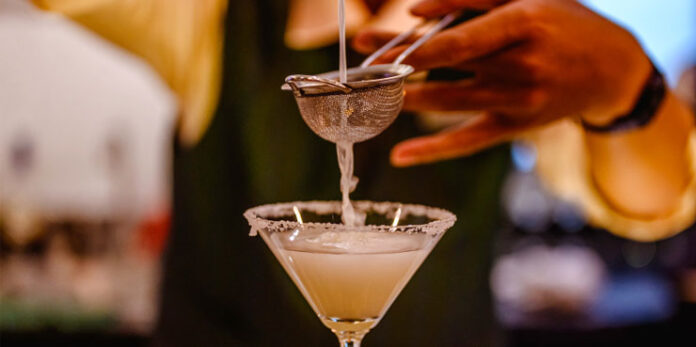Consumers are increasingly turning to better-for-you beverages, and the alcohol industry is catching on to this trend. Last year, a variety of no and low alcohol beverages made their debut.
“Lower- and no-alcohol products are continuing to gain popularity with consumers, and brewers are meeting much of the demand,” says Justin Kissinger, head of the Worldwide Brewing Alliance. “The category grew by more than 7% in volume across 10 key global markets in 2022 and this trend is expected to continue. Most of this growth (70%) will come from beer and cider, which make up 75% of the lower- and no-alcohol category. Meanwhile, in the EU, this rises to 97% of the market.”
A Taste for No-Alcohol Cocktails
One particular brand that has been rising to the top is Tilden Cocktails. Instead of copying classic alcoholic drinks, the no-alcohol cocktails brand focuses on inventive drinks, like the citrus driven Lacewing, made with cucumber, basil, lychee and Szechuan.
Alongside Lacewing is Tandem, containing notes of tart cherry, American oak, bitter orange and lapsang. Ginger and cayenne deliver a strong kick. Both of these flavors are now offered in flask-sized bottles for easy transport.
Virgin cocktails seem to hold the spotlight in the no and low alcohol space. According to a new, year-over-year study from behavioral research platform Veylinx, consumer demand is increasing for zero proof cocktails.
The study found that demand for no-alcohol canned cocktails grew by 4%, with half of respondents claiming they would drink less alcohol if better zero proof alternatives were available. This shows opportunity for yet more innovation in the beverage sector.
Demand for Low and Zero Proof Spirits

Danny Trejo’s new line of no-alcohol spirits, called Trejo’s Spirits, also aims to provide a variety of options for those looking for zero proof alternatives. The first beverage to make its debut under this new brand is a Zero Proof Blanco Tequila. New additions are expected to follow, including a mezcal, London gin, dark rum and American whiskey.
Lucas Bols is responding to the hype with a newly robust portfolio of zero-proof options. There’s Damrak Virgin, a fusion of 10 botanicals from the original gin recipe, as well as Pallini Limonzero, which uses the same Sfusato lemons from the Amalfi Coast as its boozy limoncello counterpart. The Fluère lineup of no-alcohol cocktails—raspberry, spiced cane, smoked agave and bitter—are all produced using hydrosteam distillation.
Prior to no and low alcohol going mainstream, Chinola launched a low ABV passion fruit liqueur. According to the brand’s Co-founder and CEO, Andrew Merinoff, Chinola has grown tenfold in the past three years, coinciding with the increased popularity of low-ABV options. He thinks this trend is showing no signs of slowing down.
“What we see is that consumers are not abstaining from consuming alcohol,” he notes. “They are alternating between traditional spirits and no and low ABV options, with the primary concern being the quality of ingredients.”
The Rise of No-Alcohol Beer

The beer sector also has plenty of brands brewing up the latest zero proof concoctions. New Realm Brewing Company just released their first NA beer in 2023: Non-Alcoholic Hazy IPA. In order to remove the alcohol from the beverage, the company uses a vacuum distillation process that helps keep the flavor and body of the beer while removing the alcohol.
Over the past 24 months there have been a flood of new NA beers brands and styles launched, which is bringing variety for the consumers to try for any occasion, according to Dave Deuser, CEO of Sales and Marketing, Radeberger Gruppe USA.
“Non-alcoholic beers in particular are being consumed post exercise or after a certain achievement in a celebratory way,” he says. “When you think about people getting together over a beer, it’s a friendly and happy occasion and non-alcoholic beer fits into that occasion just the same as a ‘regular’ beer.”
Kissinger also notes that beer is currently dominating the no and low alcohol space. “By contrast, beer is beer no matter how much alcohol is present. It’s still grain and water, flavored with hops and fermented with yeast,” he says. “That authenticity, along with the massive amount of resources brewers invest in developing lower- and no-alcohol brews, is a big part of why beer is dominating this space.”
The Future of No and Low Alcohol Beverages
There seems to be no sign of this trend slowing down, and even larger brands are also taking part. White Claw just released a zero proof seltzer, brand new to this year. According to the company, they taste the same as the regular malt beverages and come in a variety of flavors such as Black Cherry Cranberry, Mango Passion Fruit, Peach Orange Blossom and Lime Yuzu.
There’s still a long runway for the industry, so the sky’s the limit for more brands to get involved. According to Kissinger, the key will be shifting consumers to these products.
“At an individual level, social trends like Dry January give people the chance to try new products and approaches to see what works for them and what they enjoy,” he says. “These products open up commercial opportunities because they can help extend occasions, particularly in the on-premise, by allowing consumers to remain in beer occasions while moderating their consumption of alcohol.”









